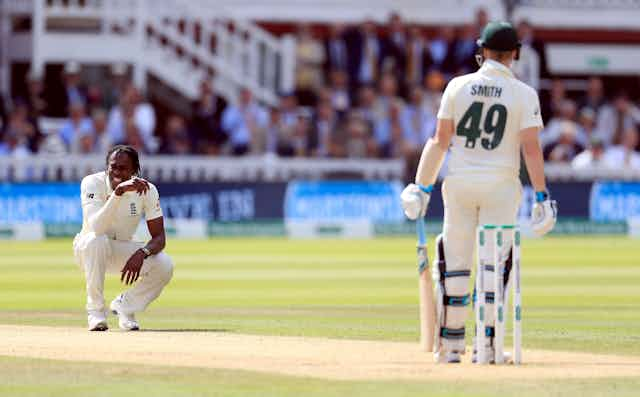Fast bowling has often been described as the most thrilling aspect of cricket, especially international Test cricket – which is played out over five days in a format designed to “test” the players’ skills to their limit.
It’s something that cricket journalists love: somehow the sight of a bowler hurling down short-pitched “bouncers” at over 90mph seems to get their juices (and their adjectives) flowing – whether or not they’ve actually faced this kind of bowling themselves, which most commentators have, unlike their newspaper colleagues. It lends itself to the idea of a “gladitorial contest” which makes for great copy.
But just how dangerous this sort of bowling can be was underlined in the most recent Test match between England and Australia at Lords. On the afternoon of the fourth day, Australia’s best batsman Steve Smith ducked to avoid a short ball which struck him on the neck. It was timed at 92mph. The blow felled Smith who had to leave the field.
Though he felt well enough to resume his innings later that day, he admitted to “feeling groggy” the next morning. He was substituted out of the match and will not play in the third Test match at Headingly in Leeds. Social media has since erupted with condemnation at what many fans – particularly Australians concerned at the fate of their star batter – see as being “brutal” and deliberately setting out to hurt the batsman.
The commentators have seen it all before. Last time it was Australian paceman Mitchell Johnson scaring the pants off English players in the 2013/14 tour to Australia. What comes around goes around – it just happens that for this Ashes contest it is England who have, in Archer, perhaps the fastest bowler in the world.
What united the press and commentators was distaste at the booing of Smith as he left the field. Some – a small minority of the Lords crowd it must be said – seem reluctant to forgive him for his part in the sandpaper scandal that rocked Australian cricket in March 2018, when the captain, vice-captain and the team’s youngest player were caught hatching a plan to doctor the ball using a sheet of sandpaper and banned for a year.
One MCC member indeed, was reportedly ejected from the Lord’s pavilion for verbally abusing Smith when he was finally dismissed for 92. It might well have been “embarrassing” for the club which acts as a custodian of cricket’s spirt of fairness, but it acted quickly and decisively.
Fast and furious
Short-pitched bowling has always been part of the game. It is part of a fast bowler’s repertoire to be able to legitimately terrify batters by sending a few whizzing past their nose.
In the early 1930s, in an attempt to nullify another Australian batting champion Don Bradman, England captain Douglas Jardine devised a strategy which involved short-pitched bowling aimed at the batsman’s body so that the consequent evasive action would most likely result in parrying the ball to one of the waiting fieldsmen. It should be noted that then, as now, England had a talented, accurate, terrifyingly fast bowler in their ranks.
Two Australian batsmen were seriously injured, and a diplomatic row between the two countries developed to the extent that 90 years later, the “Bodyline” affair still adds extra piquancy to the Ashes.
The genie was out of the bottle. Short-pitched bowling was a way to intimidate, dismiss or at least, becalm opposing batsmen. Over the years, the West Indies for example, have excelled at it. In 1976, having seen three of his batsmen injured by West Indian pace bowlers in a test match in Jamaica, Indian captain Bishen Bedi declared his team’s innings over in bitter protest.
Australia has also prided itself on the use of aggressive pace bowling over the years, with practitioners such as Dennis Lillee and Jeff Thomson terrorising opposing sides in the 1970s.
Helmets soon became as important as bats, and some would argue that the balance of power has unfairly shifted cricket towards the batter. What seems unquestionable is that batters have become more bullish in the knowledge that a blow on the head will often require nothing more than a new helmet. Indeed, Smith’s replacement in the Australian team, Marnus Labuchagne, might have thought just that when he took his eye off another express delivery from Archer on the final day of the test match on Sunday.
Having himself just become the first ever concussion replacement, under a new rule recently introduced by the International Cricket Council (ICC), it was his helmet, rather than his technique, that saved him.
Playing safe?
When Smith and Labuchagne were felled, everyone connected with the game inevitably thought of Philip Hughes. The young Australian batter was struck a fatal blow under the back of the helmet in a domestic match in 2014, and died a day or so later.
So, did we all trivialise the events at Lord’s in the interest of theatre? People being hit makes for uncomfortable viewing. Add the booing and jeering and you might have thought it was the coliseum in Rome, and not the home of cricket.
One of the main instigators of protective headwear in the first place was not even a cricketer. Having bankrolled World Series Cricket in the 1970s, media tycoon Kerry Packer insisted they were worn, not for any altruistic reason, rather because as he explained to the players, “I’m not paying you to lie around in hospital for six months.”
At least with the introduction of concussion replacements, teams are not penalised if a player is hurt, but cricket’s next looming challenge might be to work out how it successfully balances the game as a contest with player welfare. Batsmen might need better techniques as well as better helmets. Whatever the answer is, it surely is not to use the laws of the game to emasculate box office talent like Jofra Archer.

